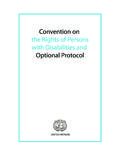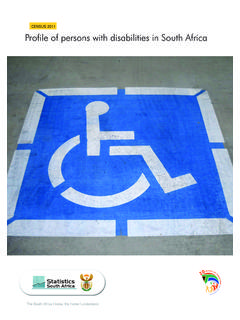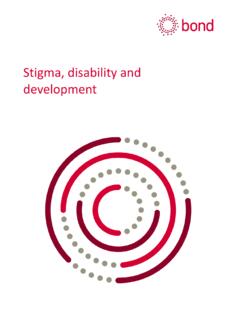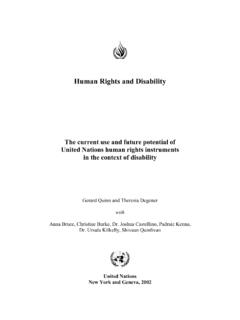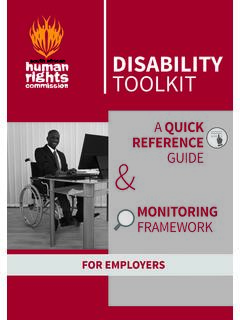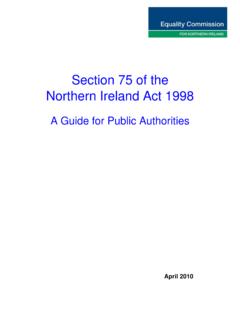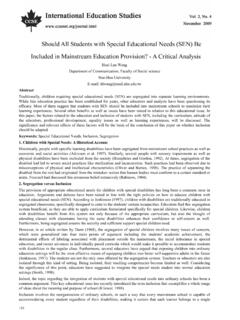Transcription of UNITED NATIONS DISABILITY INCLUSION STRATEGY
1 1 SUMMARYThe UNITED NATIONS DISABILITY INCLUSION STRATEGY provides the foundation for sustainable and transformative progress on DISABILITY INCLUSION through all pillars of the work of the UNITED the STRATEGY , the organizations of the UNITED NATIONS system reaffirm that the full and complete realization of the human rights of all persons with disabilities is an inalienable, integral and indivisible part of all human rights and fundamental STRATEGY is the result of a process launched by the Secretary-General in April 2018 to strengthen system-wide accessibility for persons with disabilities and the mainstreaming of their rights. Its development was informed by an extensive institutional review led by the Special Rapporteur on the rights of persons with STRATEGY includes a system-wide policy, an accountability framework and other implementation policy establishes the highest levels of commitment and a vision for the UNITED NATIONS system on DISABILITY INCLUSION for the next decade and is aimed at creating an institutional framework for the implementation of the Convention on the Rights of Persons with Disabilities and the 2030 Agenda for Sustainable Development, among other international human rights instruments.
2 As well as for development and humanitarian accountability framework includes two aligned components: (a) an entity accountability framework, with 15 common-system indicators, focused on four areas: leadership, strategic planning and management; inclusiveness; programming; and organizational culture; and (b) a UNITED NATIONS country team accountability scorecard on DISABILITY INCLUSION , which is currently under development and is expected to be finalized in the second half of 2019. Timetables and technical guidance, as well as the allocation of the responsibilities required for the full implementation of the policy, are also included in the the STRATEGY , the UNITED NATIONS system will systematically embed the rights of persons with disabilities into its work, both externally, through programming, and internally, and will build trust and confidence among persons with disabilities to ensure that they are valued and their dignity and rights are respected and that, in the workplace, they find an enabling environment in which to fully and effectively participate on an equal basis with a human rights-based approach to DISABILITY , in combination with targeted measures.
3 Will make the concerns and experiences of persons with disabilities an integral dimension of the design, implementation, monitoring and evaluation of policies and programmes in all political, economic and societal spheres so that persons with disabilities benefit equally. The ultimate goal is to achieve equality of outcomes and foster an inclusive culture within the UNITED NATIONS NATIONS DISABILITY INCLUSION STRATEGY2 UNITED NATIONS DISABILITY INCLUSION STRATEGYI. I. INTRODUCTIONA. Background 1. In April 2018, the Executive Committee established by the Secretary-General highlighted the urgent need for the UNITED NATIONS system to improve its performance with regard to DISABILITY inclusion1 in the context of supporting Member States to achieve the 2030 Agenda for Sustainable Development, leave no one behind and reach the furthest behind first in all UNITED NATIONS In this regard, through its decision 2018/20, the Executive Committee outlined the following tasks:(a) The Executive Office of the Secretary-General should coordinate an institutional review of the UNITED NATIONS system s current approach to mainstreaming DISABILITY into the Organization s operations.
4 (b) Building on existing work and the above-mentioned review, the sub working group of the Inter-Agency Support Group on the Convention on the Rights of Persons with Disabilities and the Department for General Assembly and Conference Management should develop a policy, action plan and accountability framework to strengthen system-wide accessibility and the mainstreaming of the rights of persons with disabilities across the Organization s Under the leadership of the Executive Office of the Secretary-General, the institutional review was con-ducted in July 2018 with the support of the Special Rapporteur on the rights of persons with disabilities. The key findings, which were considered fully when developing the UNITED NATIONS DISABILITY INCLUSION STRATEGY , included the following:(a) The UNITED NATIONS system evidences good practices in mainstreaming DISABILITY INCLUSION , which demonstrates that the system has the capacity to improve its performance; however, the good prac-tices are not systematic;(b) Gaps clearly exist in mainstreaming DISABILITY INCLUSION into all pillars of the UNITED NATIONS system at all levels, demonstrating a lack of coherent and comprehensive approaches.
5 1 The term DISABILITY INCLUSION refers to the meaningful participation of persons with disabilities in all their diversity, the promo-tion and mainstreaming of their rights into the work of the Organization, the development of DISABILITY -specific programmes and the consideration of DISABILITY -related perspectives, in compliance with the Convention on the Rights of Persons with Disabilities. This requires the development and implementation of a consistent and systematic approach to DISABILITY INCLUSION in all areas of operations and programming, internally and externally. See annex I for definitions of key NATIONS DISABILITY INCLUSION STRATEGY 3(c) While several UNITED NATIONS entities have relevant and specific responsibilities for mainstreaming DISABILITY INCLUSION , no single entity has the dedicated capacity and authority to actively coordinate, support and track At the meeting of the Senior Management Group of the Secretary-General of 6 December 2018, the out-comes of the institutional review were considered, and it was concluded that there was wide consensus on: (a) the need of the UNITED NATIONS pillars to mainstream DISABILITY INCLUSION into everything that they do.
6 And (b) the need to thoroughly address the review s findings through the system-wide approach to the policy, action plan and accountability framework. 5. The Secretary-General requested the UNITED NATIONS Department of Management STRATEGY , Policy and Compliance, jointly with the High-level Committee on Management, to look into the internal tools needed to mainstream the recommendations resulting from the The UNITED NATIONS DISABILITY INCLUSION STRATEGY will play a key role in enabling the UNITED NATIONS system to support Member States in their achievement of the Sustainable Development Goals and the implementation of the Convention on the Rights of Persons with Disabilities, the Agenda for Humanity and the Sendai Framework for Disaster Risk Reduction 2015 2030.
7 Among other international human rights instruments, as well as development and humanitarian Objectives of the UNITED NATIONS DISABILITY INCLUSION Strategy7. The UNITED NATIONS DISABILITY INCLUSION STRATEGY , through its policy and accountability framework, is a comprehensive STRATEGY for ensuring that the UNITED NATIONS system is fit for purpose in relation to dis-ability INCLUSION . It provides a foundation for sustainable and transformative change towards DISABILITY INCLUSION throughout all pillars of the Organization s work. The current STRATEGY will be implemented for five years, after which it will be reviewed and updated as Policy and accountability framework8. The policy embodies the UNITED NATIONS vision for DISABILITY INCLUSION and is a reaffirmation of a common commitment at the highest levels of the Organization.
8 It sets out the areas and functions on which the UNITED NATIONS will focus to realize the objective of achieving DISABILITY The accountability framework, which will track the implementation of the policy, will contain two aligned components, as set out below:(a) An entity accountability framework with 15 common-system indicators, which are included in the present document, against which all UNITED NATIONS entities will report annually. It focuses on the following four areas: leadership, strategic planning and management; inclusiveness; programming; and organizational culture; 4 UNITED NATIONS DISABILITY INCLUSION STRATEGY (b) A UNITED NATIONS country team accountability scorecard on DISABILITY INCLUSION , with a focus on delivery at the country level and on joint programmes and processes, is currently under develop-ment and will undergo a validation process, to be carried out by a representative sample of UNITED NATIONS country teams in the second half of The present document also includes implementation modalities for the policy at the system-wide, inter-agency and individual entity levels.
9 Annual system-wide reporting against the indicators in the frame-work will detail progress and facilitate reflection and remedial action plans at the system-wide and individual entity levels, as needed. D. Process of development11. The development of the STRATEGY was led by the sub-working group on system-wide action of the Inter-Agency Support Group on the Convention on the Rights of Persons with Disabilities between October 2018 and March The STRATEGY was developed through the intensive participation of nearly 60 UNITED NATIONS entities, inter-agency networks and civil society organizations, as well as in consultation with Member States. The STRATEGY was validated through piloting/validation with 21 entities (see annex II for details).
10 13. The STRATEGY was modelled on the UNITED NATIONS System-wide Action Plan on Gender Equality and the Empowerment of Women, which has been recognized by Member States as a pioneering accountability NATIONS DISABILITY INCLUSION STRATEGY 5II. UNITED NATIONS SYSTEM-WIDE POLICY ON DISABILITY INCLUSIONA. Preamble14. The organizations of the UNITED NATIONS system commit, through the policy, to accelerating efforts to support the achievement of the INCLUSION of persons with disabilities and their human rights through the practical implementation of the globally agreed commitments contained in the UNITED NATIONS treaties, conferences and summits and their follow-up, in particular the 2030 Agenda; the Sendai Framework; the Addis Ababa Action Agenda of the Third International Conference on Financing fo










